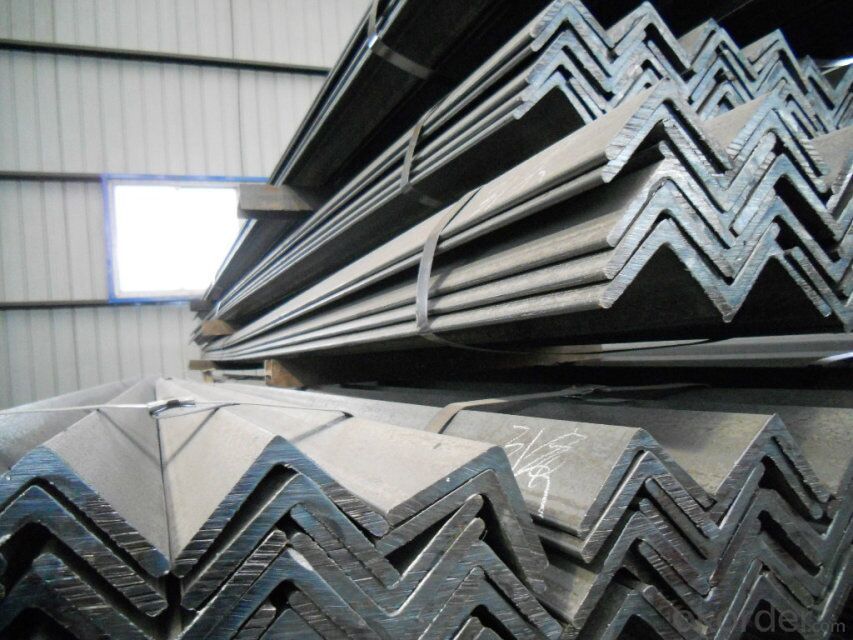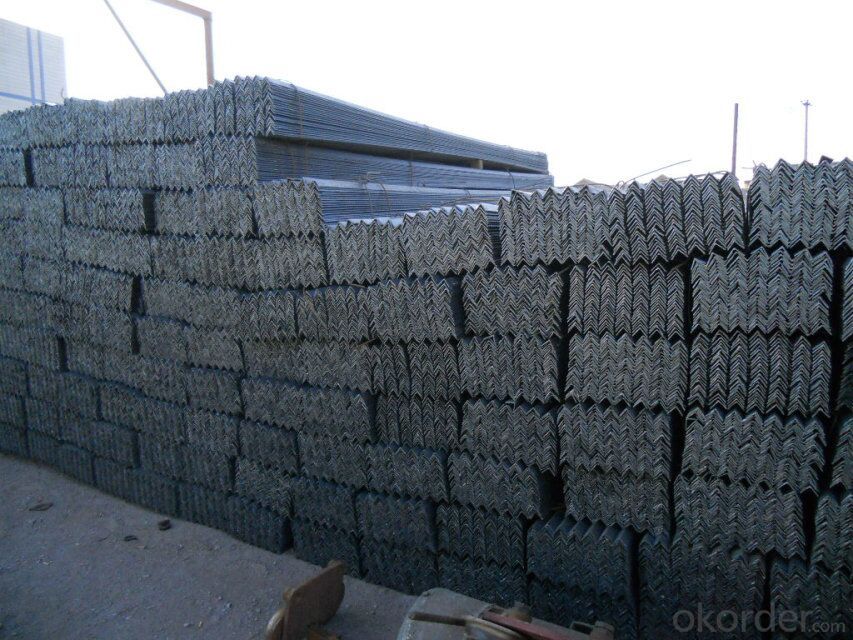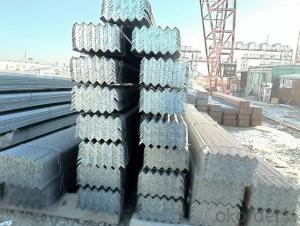Hot Rolled Steel angles in Material Grade Q235
- Loading Port:
- Tianjin
- Payment Terms:
- TT OR LC
- Min Order Qty:
- 25 m.t
- Supply Capability:
- 10000 m.t/month
OKorder Service Pledge
OKorder Financial Service
You Might Also Like
OKorder is offering Hot Rolled Equal Angles at great prices with worldwide shipping. Our supplier is a world-class manufacturer of steel, with our products utilized the world over. OKorder annually supplies products to European, North American and Asian markets. We provide quotations within 24 hours of receiving an inquiry and guarantee competitive prices.
Product Applications:
Hot Rolled Equal Angles are ideal for structural applications and are widely used in the construction of buildings and bridges, and the manufacturing, petrochemical, and transportation industries.
Product Advantages:
OKorder's Hot Rolled Equal Angles are durable, strong, and resist corrosion.
Main Product Features:
· Premium quality
· Prompt delivery & seaworthy packing (30 days after receiving deposit)
· Corrosion resistance
· Can be recycled and reused
· Mill test certification
· Professional Service
· Competitive pricing
Product Specifications:
Manufacture: Hot rolled
Grade: Q195 – 235
Certificates: ISO, SGS, BV, CIQ
Length: 6m – 12m, as per customer request
Packaging: Export packing, nude packing, bundled
Sizes: 25mm-250mm | ||
a*t | ||
25*2.5-4.0 | 70*6.0-9.0 | 130*9.0-15 |
30*2.5-6.6 | 75*6.0-9.0 | 140*10-14 |
36*3.0-5.0 | 80*5.0-10 | 150*10-20 |
38*2.3-6.0 | 90*7.0-10 | 160*10-16 |
40*3.0-5.0 | 100*6.0-12 | 175*12-15 |
45*4.0-6.0 | 110*8.0-10 | 180*12-18 |
50*4.0-6.0 | 120*6.0-15 | 200*14-25 |
60*4.0-8.0 | 125*8.0-14 | 250*25 |
FAQ:
Q1: Why buy Materials & Equipment from OKorder.com?
A1: All products offered byOKorder.com are carefully selected from China's most reliable manufacturing enterprises. Through its ISO certifications, OKorder.com adheres to the highest standards and a commitment to supply chain safety and customer satisfaction.
Q2: How do we guarantee the quality of our products?
A2: We have established an advanced quality management system which conducts strict quality tests at every step, from raw materials to the final product. At the same time, we provide extensive follow-up service assurances as required.
Q3: How soon can we receive the product after purchase?
A3: Within three days of placing an order, we will begin production. The specific shipping date is dependent upon international and government factors, but is typically 10 to 30 workdays.
Images:


- Q:Can steel angles be used in construction?
- Yes, steel angles can be used in construction. Steel angles are commonly used as structural elements in construction projects due to their strength, durability, and versatility. They are commonly used to support and reinforce various structures such as buildings, bridges, and industrial frameworks. Steel angles provide stability and structural integrity, making them a suitable choice for construction purposes.
- Q:What are the factors to consider when choosing the appropriate steel angle size?
- When choosing the appropriate steel angle size, several factors need to be considered. These include the required load-bearing capacity, the structural design and stability requirements, the dimensions and shape of the application, the material strength and durability needed, and any specific industry standards or codes that govern the intended usage. Additionally, factors like cost, availability, and ease of installation may also influence the selection of the steel angle size.
- Q:Are steel angles suitable for scaffolding?
- Yes, steel angles are suitable for scaffolding. They are commonly used in scaffolding systems due to their strength, durability, and ability to provide stable support for workers and materials. Steel angles offer excellent load-bearing capacity and can withstand heavy loads, making them a reliable choice for scaffolding structures.
- Q:Can steel angles be used in outdoor or exposed environments?
- Yes, steel angles can be used in outdoor or exposed environments. Steel angles are often made of galvanized steel, which is coated with a protective layer of zinc to prevent rusting. This makes them highly resistant to corrosion and suitable for outdoor applications. Additionally, steel angles are known for their strength and durability, making them a reliable choice for various outdoor structures, such as fences, railings, and supports. However, it is important to note that regular maintenance and inspection may be required to ensure the ongoing integrity and performance of steel angles in outdoor or exposed environments.
- Q:What are the common methods of surface preparation for steel angles?
- Common methods of surface preparation for steel angles include abrasive blasting, such as sandblasting or shot blasting, to remove rust, scale, and contaminants from the surface. Chemical cleaning can also be used to remove oils, greases, and other organic materials. Additionally, mechanical cleaning methods like wire brushing or grinding can be employed to smooth out rough surfaces and remove any remaining debris.
- Q:Bearing capacity of angle steel and channel steel
- Angle called angle, the steel strip is perpendicular to each other on both sides into the corner. There are equal angles and unequal angles. The two sides of an equal angle steel are equal in width. The specifications are expressed in millimeters of edge width * edge width * edge thickness. Such as "/ 30 x 30 x 3", that is 30 mm width equal angle, edge thickness of 3 mm. Also available models that model is the number of centimeters wide, such as angle 3#. The model does not mean the size of the different edges and sizes of the same model. Therefore, the width, the edge and the thickness of the angle iron should be filled out in the contract and other documents, so as not to be indicated by the model alone. Standard Specification for hot-rolled equal angle iron is 2#-20#. The angle iron can be made up of different force components according to the different structure, and can also be used as the connecting piece between the components. Widely used in a variety of architectural and engineering structures, such as beams, bridges, towers, hoisting and conveying machinery, ships, industrial furnace, reaction tower, container frame and warehouse.Angle steel performance index: the performance test of angle iron is mainly tensile test and bending test. Indicators include yield point, tensile strength, elongation and bending compliance.
- Q:What are the different surface finishes available for painted steel angles?
- Painted steel angles offer a range of surface finishes to meet aesthetic and functional needs. 1. Achieving a smooth finish involves evenly applying a coat of paint and then curing it for durability. 2. Textured finishes create a rougher surface with patterns or textures, achieved through techniques like sandblasting or textured paint. These finishes enhance grip and reduce slipperiness in applications requiring traction. 3. Matte finishes have low sheen or gloss levels, resulting in non-reflective surfaces. This option is ideal for applications desiring a subdued appearance. 4. On the other hand, glossy finishes have high sheen or gloss levels, creating reflective and shiny surfaces. They provide a polished and visually appealing look to painted steel angles. 5. Powder-coated finishes are popular for their durability. This method involves coating the steel angle with a dry powder, which is then cured under heat to form a protective layer. Powder-coated finishes offer excellent resistance to scratches, chemicals, and UV rays. 6. Galvanized finishes involve applying a layer of zinc to the steel surface, providing corrosion resistance. While typically not painted, galvanized steel angles can be painted over if desired, allowing for various color options. In summary, painted steel angles offer a variety of finishes including smooth, textured, matte, glossy, powder-coated, and galvanized. The choice depends on the intended use, desired appearance, and required durability for the application.
- Q:What are the different types of surface finishes available for steel angles?
- There are several different types of surface finishes available for steel angles, each providing unique characteristics and benefits. 1. Mill Finish: This is the most basic and common type of surface finish for steel angles. It is essentially the raw, untreated surface of the steel, which may have some imperfections and roughness. Mill finish is often used for structural applications where aesthetics are not a priority. 2. Hot-Dip Galvanized: This surface finish involves immersing the steel angle in a bath of molten zinc, creating a protective coating that prevents corrosion. Hot-dip galvanized steel angles are highly resistant to rust and can be used in outdoor or corrosive environments. 3. Powder Coated: Powder coating is a process where a dry powder is electrostatically applied to the steel angle and then cured under heat. This creates a durable and attractive finish that provides excellent resistance to chipping, scratching, and fading. Powder coated steel angles are commonly used in architectural and decorative applications. 4. Painted: Steel angles can also be painted with various types of paint, such as epoxy, enamel, or acrylic. Paint provides a protective layer and can enhance the appearance of the steel angle. However, painted surfaces may be more susceptible to chipping and require periodic maintenance. 5. Stainless Steel: Stainless steel angles have a naturally smooth and polished surface due to their composition. They are highly resistant to corrosion and staining, making them suitable for applications in industries such as food processing, pharmaceuticals, and marine environments. 6. Shot Blasting: Shot blasting is a surface treatment process where steel angles are bombarded with small metallic or non-metallic particles at high velocity. This removes any rust, scale, or contaminants from the surface, resulting in a clean and roughened finish. Shot blasting prepares the steel angle for further coating or painting. These are just a few examples of the different types of surface finishes available for steel angles. The choice of finish depends on the specific requirements of the application, including factors such as corrosion resistance, aesthetics, durability, and cost.
- Q:What is the maximum allowable lateral torsional buckling stress for a steel angle?
- The maximum stress that a steel angle can withstand before lateral torsional buckling occurs depends on several factors, including the angle's size, shape, material properties, and the design code being followed. To determine the maximum allowable stress for a steel angle, one can consider the critical moment of inertia and its corresponding critical stress. The critical moment of inertia measures the angle's ability to resist lateral torsional buckling and is affected by its geometry and dimensions. Design codes such as the AISC Manual of Steel Construction or the Eurocode provide specific values for the maximum allowable lateral torsional buckling stress. These codes offer guidelines and formulas for calculating this stress based on the angle's dimensions, material properties, and other factors like effective length and end conditions. To accurately determine the maximum allowable lateral torsional buckling stress for a particular steel angle, it is crucial to refer to the appropriate design code or standard and seek advice from a structural engineer or consult relevant reference materials.
- Q:Can steel angles be used in the construction of bridges?
- Yes, steel angles can be commonly used in the construction of bridges. Steel angles are versatile structural components that can provide additional strength and support to bridge structures. They are often used in the construction of bridge decks, railings, and supports. Steel angles are known for their high strength-to-weight ratio, which makes them ideal for bridge construction. They can withstand heavy loads and provide stability to the bridge structure. Additionally, steel angles are durable and resistant to corrosion, which is essential for bridges that are exposed to various environmental conditions. In bridge construction, steel angles are often used in conjunction with other steel components, such as beams and columns, to create a strong and reliable structure. They are commonly used as bracing elements to reinforce the overall stability of the bridge. Steel angles can also be used as connection elements, allowing different parts of the bridge to be securely joined together. Overall, steel angles are a crucial component in bridge construction, providing strength, durability, and stability to the structure. Their versatility and reliability make them a preferred choice for engineers and designers when constructing bridges of various sizes and types.
1. Manufacturer Overview |
|
|---|---|
| Location | |
| Year Established | |
| Annual Output Value | |
| Main Markets | |
| Company Certifications | |
2. Manufacturer Certificates |
|
|---|---|
| a) Certification Name | |
| Range | |
| Reference | |
| Validity Period | |
3. Manufacturer Capability |
|
|---|---|
| a)Trade Capacity | |
| Nearest Port | |
| Export Percentage | |
| No.of Employees in Trade Department | |
| Language Spoken: | |
| b)Factory Information | |
| Factory Size: | |
| No. of Production Lines | |
| Contract Manufacturing | |
| Product Price Range | |
Send your message to us
Hot Rolled Steel angles in Material Grade Q235
- Loading Port:
- Tianjin
- Payment Terms:
- TT OR LC
- Min Order Qty:
- 25 m.t
- Supply Capability:
- 10000 m.t/month
OKorder Service Pledge
OKorder Financial Service
Similar products
New products
Hot products
Related keywords




























